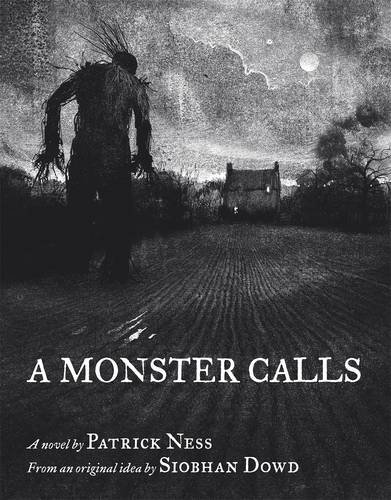
Candlewick Press, September 27, 2011
young adult magic realism
Summary:
Thirteen-year-old Conor has been waiting for the monster ever since the nightmare started at the beginning of his mother’s sickness. Only this one is far too old, far too wise and far too intimidating for comfort. Once it starts its three tales of truth, there’s no going back for Conor until he’s told the monster his own story. His own true story.The cover:
WOW. It might just be the illustration style, but this is such an artistic cover. The silhouette of the monster is the highlight; it draws our eye towards the path it travels, towards the house that is its inevitable destination. It sparks thrilling anticipation and sets the mood perfectly.
The book:
Oh, sigh. Guys. This book. It’s pure loveliness. Everything from the idea itself to the writing style to the ending—I’m pretty sure my heart broke, oh, a couple dozen times during A Monster Calls.
It’s difficult to believe Patrick Ness has no prior middle-grade books. With the smallest details, Ness captures a thirteen-year-old’s voice shatteringly perfectly. For example, Conor describes cereal that “tasted as unhappy as it looked”, instead of saying something like “it tasted as gross as it looked.” It’s part of that perspective middle-graders have, and it wins the reader over to Conor’s side, despite the intended audience being teens.
One could argue this book has no plotline. Instead, the author devotes each short chapter to developing character: Conor’s, his father’s, the bullies’ at school. The grandmother comes off especially realistic, somehow splitting our favours to both her and Conor when it comes to a face-off between them. The estranged American father adds yet another troublesome touch in addition to Conor’s problems at school. In fact, one could say there’s too much trouble: Harry the bully’s development arc seems abruptly cut off, never giving the reader a full reason for his torment of Conor.
The stories the monster tells are little jewels in themselves. As Conor finds out, there’s no black and white: the prince murders the princess to overthrow the witch queen; the good preacher’s house is thrashed while the corrupt pharmacist gets off scotch-free; there are worse things than being invisible. The illustrations within are the perfect accompaniment to these multi-layered stories, and they give such an excellent sense of dimension, in terms of physical size and metaphorical grandness. And the ending—excuse me, I’m going to have to lose all professionalism here—
I swear I wasn’t crying until the very last two pages. I was, in fact, awaiting an answer as to why Conor’s mother knows about the yew tree as well. But then the monster says, “Not yet… not just yet.” And then the time 12:07 comes into play. And I break down. So. Yeah. You should read this book.
Rating: 4.4 out of 5








